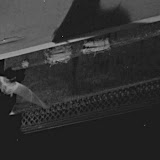
Our friends the bats are really active today. Normally, they make a bit of noise when they see me walk by the bat house in the backyard, but today, lots of screeching. (High-pitch squeaks that sound a lot like insects -- see the audio/video post below).
In fact, one individual actually came out a bit onto the landing area to screech at me. I snapped a couple pictures with my digital camera, but I had to crop and enhance them a lot since the bat and the bat house are silhouetted against a very bright sky, and the bat is very dark against the brown-painted landing area.
The image above is a heavily contrast-enhanced version of the image. I was standing on a short step ladder, about six feet from the bat house.
Here's a shot cropped to show just the bat house opening, but only enhanced slightly so that you can see the true colors. No wonder bats are so hard to see at night -- they're flying fast, they're pretty much silent (to us) and they're dark brown or black.

Why so much activity? I have several theories, none of them really tested (or testable).
First, we've had a lot of rain. Over the past ten days, I measured about 13 inches of rain. This could have a couple of implications for the bats. For one thing, there were many nights were it was tough to even get out of the bat house for the driving rain, and I suspect that hunting for insects is more complex when it's raining hard. (Notice how much later the bats emerge on the rainy nights graphed in the posts below. ) For another, the insect population is now booming with mosquitoes and other insects very prevalent at my house. This means more food after a possibly hungry, rainy interval. Maybe this has got the bats more worked up?
Second, perhaps they have pups? I don't know the mating habits of bats, but I'd suspect that they may have young now. If so, then maybe the individual peeking out so aggressively (well, for a normally very shy species, anyway) has the role of sentry or guard?
Time to count some bats at the evening emergence soon.


